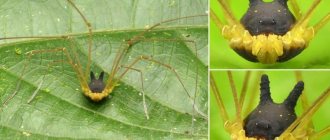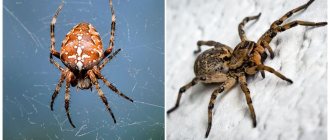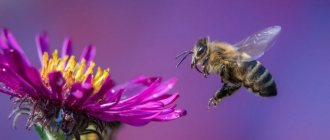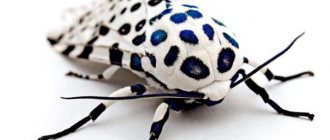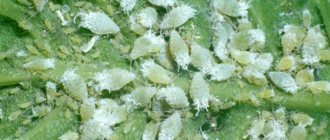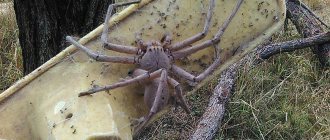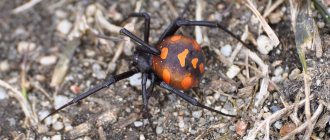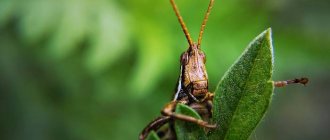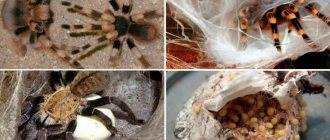Spiders in Latin are Araneae, Aranei. They belong to the animal kingdom, the phylum of arthropods, the class of arachnids. There are 42 thousand modern species of spiders in the world, about 1.1 thousand fossils. They are widespread, inhabiting almost all continents of the globe. Obligate carnivores - feed on insects, small animals, and amphibians. An exception is the jumping spider Bagheera kiplingi, whose diet consists of the green part of the acacia tree. On the territory of Russia and the former CIS countries there are 2888 species. The science of spiders is called arachnology.
Description of the spider
The spider is the most ancient creature on the planet. It is much older than humans; these organisms arose in advance. The remains of vital activity, spider webs, were discovered in the structure of amber, which is 100 million years old.
Arachnids lived on the globe back in the Paleozoic era, and this was 2.5 billion years ago. During this period, these creatures practically did not change in appearance.
To understand who spiders are, it is worth considering their features and description of their appearance. They have 6 pairs of limbs. However, the person notices 4 pairs. This is due to the fact that the first 4 limbs are transformed into organs of nutrition and touch.
- The body of arthropods is divided into two parts - the cephalothorax and abdomen. They are connected using a short jumper;
- the cephalothorax is divided by a groove into the head and thoracic parts;
- on the chest part there are the limbs of the spider, due to which it moves and weaves a web;
- on the surface of the head there are two pairs of limbs, eyes and a mouth opening.
The number of eyes may vary. Most arthropods have 8 visual organs. But in individuals living in the darkness of caves, they may be absent.
Main differences
With minimal knowledge of biology, one can easily discover that between these species of arthropods there is very little even external similarity, not to mention origin and numbers. Even the appearance of spiders and insects on Earth dates back a hundred million years. The last species appeared on Earth 100 million years later than spiders, which have lived on the planet for more than 400 million Earth periods.
Further differences are even more noticeable:
- there are about 43 thousand species of spiders (42 thousand modern and 1100 fossils), and more than a million insects have been described, and there are suggestions that this is not a complete list;
- spiders are obligate predators, there is only one known species that feeds on acacia, while the feeding of insects varies depending on the stage and species;
- web weavers have eight legs, while their opponents have six; the difference in structure is difficult to compare due to the huge number of varieties of the latter category;
- although spiders are also found with six or 2 eyes, in most cases they have 8 organs of vision, and insects have compound eyes consisting of ommatidia for comprehensive viewing;
- almost all tracheal breathers have digestive organs, even in their infancy, and a mouth for absorbing food, and in spiders, food digestion occurs outside the intestine, after injecting enzymes into the body of the victim;
- insects have an exoskeleton, head, thorax and abdomen, while spiders have only a cephalothorax and abdomen, although there are some species in which the head and thorax are separated by a groove, but still do not constitute separate body segments.
It is difficult to list the structural features, size and dimensions of insects, since there are a myriad of them. But the main differentiation is usually made by the type of digestion.
Spiders, being earlier inhabitants of the Earth, are equipped with hooks and channels for injecting poison into the food they catch. Enzymes that enter the body of the prey dissolve its contents, and the obligate predator can only suck out the contents.
This makes the arthropod dependent on external circumstances - the web, the opportunity to lie in wait, the time required to obtain a kind of soup.
The insect immediately absorbs the food received and digests it inside the body. This gives him the opportunity to get enough faster and not waste precious time, which means a greater chance of survival in interspecies struggle. Therefore, insects became a more branched branch of evolution.
Why are people afraid of spiders
In science, a pathological fear of arachnids is called arachnophobia. The disease is accompanied by severe attacks of fear that develop when meeting individuals of any size.
Attacks may be accompanied by fainting, headaches, sweating, dizziness, nausea, and a desire to run away from the animal. Experts have found out an interesting fact about patients with a similar deviation - many of them are not able to explain their fear.
In many cases, arachnophobia is a consequence of experiences with arachnids that a person had in childhood. Today, deviation is considered the most common and difficult to treat phobia.
Spiders of Russia
In Russia you can meet a wide variety of spiders. It is estimated that the country is home to approximately 2,880 species with specific characteristics. Below are the main and most common ones.
House spider
House spider
This species prefers to live in residential buildings and outbuildings. It eats small insects: bedbugs, moths, flies, etc. If there are no human settlements nearby, it can live in fields and forests, using a crack in a tree or thick grass as a home. The color of the spider is yellow-brown, with a dark pattern on the back. An adult grows up to 1.2 cm.
Orb weaver
Orb weaver
A poisonous spider that lives in nature. The predator climbs trees and weaves a large round web between the branches, into which insects fall, which later become food. Orb weavers can also hunt frogs, rats and other small animals.
Interesting fact : the poison of the orb weaver paralyzes the frog in 15 minutes. For humans, the bite is practically harmless, although there may be discomfort in the affected area.
Argiope arthropod
Argiope arthropod
Males of this species rarely grow more than 5 mm, but females stretch up to several centimeters. The spider is yellow and black in color, which makes it look like a wasp. Argiope is found in central Russia. The spider is poisonous and rarely attacks first in case of danger. Having spread a web, the predator often sits right in its center and does not hide from potential prey.
Hyracantidae
Hyracantids
This species of spider lives in grass and dense thickets and loves temperate climates. Adults grow up to one and a half centimeters. The color is light brown, sometimes there may be a green tint. Chiracantids are nocturnal, do not build permanent housing, travel across territories and hunt insects. The bite is considered highly poisonous.
South Russian tarantula
South Russian tarantula
Grows up to 3 cm, prefers areas with low humidity, mainly steppes. He builds a house in loose soil, digs a hole several tens of centimeters deep. During the hunt, he sits inside and waits. When an insect runs nearby, the tarantula jumps out of the hole and bites the prey. The poison almost immediately paralyzes the enemy, and the spider only has to drag him home.
Silver spider
Silver spider
In Russia, you can find the silver spider in the Far East, Siberia and the Caucasus. The legs and front part of the predator's body are dark brown, the back part is gray. The size of an adult does not exceed 2 cm. The silver spider has a calm character and does not attack without reason. Spends most of its time in water, where it hunts small creatures.
Steatoda
Steatoda
Species is found in the Caucasus and southern Russia; it prefers to settle next to humans and hunt in gardens and vegetable gardens. The spider is black in color with orange-red or gray patterns on the back. It is poisonous, but the bite is not capable of causing severe harm to humans. But it quickly helps to cope with insects.
Black Eresus
The Black Eresus
Spider has a rather unusual color, which makes it look like a ladybug. Eresus lives in the Rostov and Novosibirsk regions. It digs a small hole as a home, to which it is attached all its life. Often the male and female live together to regularly produce offspring. The spider grows up to 2 cm in length.
Solpuga
The Salpuga
Spider lives in the Crimea, has white-yellow legs and a gray body, which is why it is perfectly camouflaged in the sand. It is most active at night and can move quickly. When hunting, it uses long jaws, which help cope not only with insects, but also lizards and rodents. Salpugs grow up to 7 cm in length.
Pouch spider
The pouch spider
is an aggressive predator that is capable of attacking even a large opponent. It has an elongated body of yellow color with a greenish tint. Lives in the Volgograd and Rostov regions. Prefers to live in fields with tall grass, but can also be found near trees. The average length of an adult is 1.5 cm.
False black widow
False Black Widow
The False Black Widow is dark in color and sometimes has red spots on its body. Individuals with light-colored paws are also sometimes found. The spider grows no more than 1.2 cm in length and hunts small insects. Considered highly poisonous. The bite can cause discomfort to a person for 2-3 days. The bulk of the population lives in Dagestan.
Is a spider an insect or not?
Many people wonder whether a spider actually is an insect or an animal. Most will immediately answer that it is an insect, but this is not the case. Even if in appearance this organism looks like crawling small inhabitants, it is in no way related to them and has distinctive features.
They are animals; among the inhabitants of the fauna they are classified as invertebrates. These are arthropods that have jointed limbs, a hard chitinous cover, which is a hard exoskeleton.
Therefore, the question arises why spiders are not insects and animals. And also interested in what exactly connects mammals, what common features they have with insects and differences from them. This is worth considering carefully.
General signs
The family of spiders and insects share some common characteristics. This is due to the fact that arachnids belong to the class of arthropods.
They have the following characteristic qualities:
- creatures have a chitinous skeleton to which muscles are attached;
- the structure of the eye in arthropods is formed from many ocelli; it is often called facet;
- females reproduce by laying eggs.
Main differences
To understand what a spider is - an animal or an insect, it is worth carefully considering its main characteristics.
- spiders have 8 legs, and insects have 2 fewer;
- Insects have 3 body segments, and arachnids have 2;
- spiders are able to weave webs;
- In nature, insects have a huge number of species and subspecies;
- arthropods produce poison, which is required for external digestion of food;
- unlike insects, arachnids do not have metamorphism (transformation) in their life cycle;
- The communication system and nervous system of insects is much more complex than that of arthropods.
Insects and spiders
These two types of arthropods are often confused. But they have much more differences than they have in common. Among insects, there are those that eat meat and those that are vegetarians. Spiders are mostly predators.
Spiders are definitely not insects! More differences in the structure and behavior of insects and spiders in the article at the link.
Spider Anatomy
Spider eyes The number of eyes is not an indicator of good vision. And spiders are a prime example of this.
Spider legsThe limbs perform not only a walking role. They help in hunting.
Spider reproductionThe method of reproduction of spiders is determined by their lifestyle and structural features.
Signs of insects
The insect's body is divided into head, thorax and abdomen. The head consists of five fused segments. There are antennas on the head with receptors for touch and smell. The eyes are compounded, that is, they consist of many simple ocelli. There are mouthparts for chewing food.
The chest includes segments: anterior, middle and posterior. Each segment carries a pair of motor limbs. In addition, the middle and hind ones each include a pair of wings: chitinized elytra and, in fact, wings. The abdomen also consists of segments, on the sides of which paired respiratory openings open.
How do they breathe
Respiratory system of spiders
Depending on the species, spiders may have the following variations of the respiratory system:
- one pair of lungs;
- two pairs of lungs;
- a pair of lungs and a pair of tracheas;
- pairs of sieve and tubular tracheas;
- pair of sieve tracheas.
Getting inside the spider through special holes, oxygen is transported through the hemolymph to the respiratory organs with the help of hemocyanin. The lung sacs are located in the front of the abdomen. They saturate the body with oxygen through the circulatory system. Also behind the pulmonary sacs are bundles of tracheae, which are small tubes. They exit through a single breathing hole. During exhalation, the spider releases the resulting carbon dioxide into space.
Interesting facts about spiders
Unusual facts about spiders will amaze many who do not yet know about these creatures. But they conceal many mysteries, secrets, and have unique features that other organisms living on the globe do not have.
Let's look at 15 interesting facts about spiders:
- The web is not only a trap for insects, it is capable of deflecting several millimeters in order to grab and stick an insect to itself. This phenomenon is carried out due to a static charge, which appears during the flight of the insect.
- The bite of the Brazilian wandering spider is not always fatal, but it often causes impotence in men.
- With the help of its limbs, the spider can determine what has reached it in the web. But edible or inedible helps him establish the olfactory organs, which are located on his legs.
- The animal has a durable shell. Its strength can withstand a nuclear explosion.
- The web is very light. If you take a spider thread the length of the earth's equator, then its weight will be only 340 grams.
- Spider web is considered a powerful and durable material. If its thickness is increased to the thickness of a pencil, then such a web could stop a Boeing. In New Guinea, fishermen use this material to catch fish, and in South America there are spider web bridges that support monkeys.
- The lifespan of arthropods is 30 years. But they rarely die of old age.
- At one time, the female can lay up to 20 thousand eggs, from which spiders hatch.
- In nature, there are varieties of spiders that, after being born, eat their mother.
- There are varieties of arachnids in which the brain occupies the largest part of the body, so other organs are forced to be located on the legs. The smaller the spider, the larger its brain.
- In the Netherlands there are more spiders than people. For 15 million human population there are 5 thousand billion arthropods.
- In Cambodia, people enjoy eating tarantula spiders. They are also brought up at home, they learn to dance, and play willingly. And if necessary, they can protect the owner.
- There are types of spiders that do not weave webs - the jumping spider, the lynx spider. They do not catch prey with webs, but hunt it.
- Tarantulas can live without food for about two years.
- The gladiator got its name due to the fact that it weaves a web in a square. He does not leave her until the prey falls into her; he himself abruptly throws the net on her, thereby leaving no chance to escape.
Interesting Facts
Spiders inspire fear in people, but at the same time they inspire interest. Therefore, they are studied and even raised at home as pets.
Flying spiders There is evidence that some species of spiders can fly. And this is not to instill fear in the impressionable. This method is a protection and a method of movement.
Spiders with a tail There were individuals that had a tail. Unusual tailed spiders and their descendants.
Spider web Spider web is a durable and stable material; it can stretch many times and return to its original position.
How to get rid of house spiders
The first step is to remove those insects that serve as food for spiders, which is why it is first necessary to destroy cockroaches, bedbugs, flies and other unpleasant insects. Next, you should remove the cobwebs. It is very convenient to do this with a vacuum cleaner, the bag of which is emptied outside the home after the procedure. You can fight cobwebs with an ordinary broom. However, if there are a large number of arthropods, this may indicate the presence of masonry, which can be gotten rid of using household chemicals - these creatures do not tolerate strong aromas. If possible, surfaces regularly inhabited by arthropods can be painted.
Also, if spiders begin to appear frequently, you can place containers with flavored liquids around the room. Thus, arthropods cannot tolerate the aromas of chestnut, citrus, mint, and eucalyptus. The number of spiders will sharply decrease, and after some time the unpleasant neighbors will leave your home.
However, if the spiders have managed to breed, you will have to purchase special chemicals aimed at destroying them. First of all, these are products based on pyrethroids.
An excellent preventive measure would be to keep the room clean and regularly remove dust and dirt, especially in hard-to-reach places. It is not for nothing that spiders are considered indicators of cleanliness: in those rooms where a lot of them have accumulated, the conditions are far from complete sanitation.
Internal structure
Spiders have a complex internal structure. They have circulatory, excretory, respiratory, digestive, and nervous systems.
Digestive system
The intestinal canal runs directly from the mouth to the anus. Consists of 3 parts. Divided into the esophagus, stomach with five pairs of blind tubes, and intestines. Processing and absorption of nutrients occur in the stomach. The intestines include two branched urinary canals. Liver juice has an effect similar to that of the pancreas of higher vertebrates.
Foregut
Consists of the pharynx, sucking stomach, and esophagus. Covered with chitin. Equipped with powerful muscles. The esophagus is thin and tubular. Forms a right angle with the pharynx. The sucking stomach has the shape of a pyramid with 4 sides. It absorbs part of the food. It also helps with swallowing as it has strong muscles.
Stomach
The stomach of spiders is the anterior section of the midgut. It does not have an internal cuticle. Represents large branched protrusions. It happens: simple, intermediate, classic, complex. Connects to the intestine, which extends through the stalk into the abdomen.
Liver
Large bulge on the intestine at the beginning of the abdomen. Gray or brown. Consists of many blades (lobes). Surrounds all organs except the pulmonary sacs. Releases digestive enzymes and destroys semi-digested food particles.
Cloaca
A voluminous pouch at the end of the intestine. This is where excrement accumulates. The Malpighian vessels flow into it. It continues with the chitinous hindgut. Followed by the anus. Spiders defecate droplets of liquid. After drying, the stains from them become white with a dark center.
Respiratory system
The respiratory organs are unique. The hemolymph of many spiders contains the respiratory pigment hemocyanin. It speeds up metabolic processes. The number of spiracles corresponds to the number of respiratory organs.
Lungs
Consist of many plates. Their appearance resembles a stack of paper. Primitive groups of spiders have 4 lungs. In most spiders, the posterior pair of lungs is transformed into trachea. There are representatives who do not have this body. That is, according to the way they breathe, spiders are divided into:
- Quadruple lungs;
- bipulmonary;
- lungless.
Trachea
Oxygen enters them through air holes. According to development and location, there are local and general significance. The second ones extend into the cephalothorax and limbs. The first ones do not extend beyond the abdomen.
The trachea is more efficient for breathing than the lungs. This has been confirmed by experiment. The stigmata of spider lungs were covered with Vaseline. After 4-7 hours, blood circulation stopped. Then the spider died. Representatives of species with developed tracheae lived significantly longer during the experiment.
Interesting fact. The water spider has predominantly cutaneous respiration. With completely covered spiracles, it lives 4-15 days. Underwater it breathes oxygen, which collects between the hairs on the body.
Circulatory system
The circulatory system is not closed. Heart pulsating. Located in the abdominal cavity. It has lateral stomata that help pump hemolymph (the equivalent of white blood). When the heart contracts, blood enters the artery and the lateral stomata close like valves. Flows through the arteries to the extremities. It rotates around the lung sacs, then returns through the lateral stomata into the posterior vessel.
central nervous system
Consists of the brain and subpharyngeal nerve mass. Concentrated in the cephalothorax. It consists of paired ganglia that act as local control centers for all segments. The brain is created by the fusion of ganglia. Spiders have a centralized nervous system, characteristic of arachnids. There are two visual centers in the brain. One is responsible for the main eyes, the other for the others.
Despite having a relatively small central nervous system, some representatives exhibit complex behavior. For example, the ability to use trial and error.
Species and subspecies
Answering the question of what kinds of spiders there are, it is worth noting that these creatures are divided into species and subspecies, which have some distinctive features.
In nature, there are about 35 thousand species of archanids or arachnids, which differ in appearance.
Different types of spiders have characteristic forms of life activity, which include reproduction, feeding habits, habitat in natural conditions, and size.
- their body consists of two parts - the abdomen, which can have different shapes, it all depends on the type of arthropod, as well as the cephalothorax;
- characterized by the presence of 4 pairs of legs, 2 chelicerae and pelipalps;
- spiders do not have whiskers;
- the main feature of the creatures is to weave webs for various purposes, and its design may have some peculiarities;
- there are poisonous glands, the poison of which has a paralyzing effect on the victim;
- prefer to lead a solitary lifestyle. Most females, after fertilization, eat a select few.
It is impossible to know exactly how many spiders there are in the world, because there are many of them.
At one time, a female is capable of laying 15-20 thousand eggs, most of which hatch into spiders, so it is difficult to imagine how many dozens of females can lay and give birth at a time.
The classification combines many types. In nature, there are exotic representatives of arthropods that do not pose a danger to humans; they are preferred as pets.
It is worth paying attention to the dangerous and poisonous breeds of spiders; they inhabit the tropics and other hot areas, for example, deserts.
What types of spiders are there?
Large pink tarantula.
There are more than 40 thousand species of spiders. They can live in grass, near human habitation and in remote places.
There are very miniature spiders, but there are also large representatives that do not fit on a plate. But all species have the same structure.
Conventionally, types of spiders can be divided into:
- woody;
- domestic;
- safe;
- poisonous.
In Russia, according to the latest data, there are about 2,400 species. More and more of them are opened every year. They are distributed in different regions and climates.
A detailed acquaintance with the spider fauna of Russia.
Distribution and habitat
Spider in the forests of Russia Spiders live on all continents except Antarctica. Being invertebrate animals, they cannot control their body temperature and are susceptible to cold, however, in northern Canada, Greenland and northern Russia they get along well.
They are one of the few species of animals that get along well in the highlands. There are certain species that feel great even in an aquatic environment.
The main factor that limits their habitat is the availability of food.
How do spiders weave webs?
All spiders can create webs. In the early days, they used their own yarn as an insurance policy. Then they began to weave carpets in order to recognize the approach of prey by the vibrations of the threads. And finally, we learned how to create clever traps.
The web is produced by the arachnoid glands. They are located in the abdomen (under the liver, near the longitudinal muscles). They emerge as spider warts. Which have hairs called tubules. Their average number is 400-600. The tubes are connected to the glands. Spiders have several types of glands. Each is capable of producing webs with different properties. For example, sticky is never used to weave an egg cocoon.
The spider has complete control over the processes associated with the web yarn. How a spider spins a web:
- His brain analyzes the task.
- Sends a signal to the desired gland.
- It releases a protein mixture.
- It is directed through the channels to the tubes.
- Goes outside.
- The individual presses the warts to the surface, thereby attaching the tip of the future thread.
- It begins to move, pulling out the web from itself.
Sometimes, during the production of webs, he can comb them with his paw. This entangles the fibers to achieve greater strength.
What order and class do spiders belong to?
If we talk about what class spiders belong to, then this is the class “arachnids”. It stands apart from all others, which is associated with the characteristic features of the body structure of arthropods.
They have it divided into two parts - the abdomen and the cephalothorax, but in representatives of other classes the body has a slightly different structure.
There is another characteristic difference - the number of legs. Arthropods have 8 of them instead of 6. They have chelicerae, which are located on the front of the cephalothorax.
They also have pedipalps, which look like tentacles. They are located on the sides of the body and perform the same functions as the paws.
These organisms belong to the order Spiders, the family Arthropods. Spiders are often called "archans", this name comes from the name of the suborder to which these creatures belong - Orthognatha.
It is distinguished by species diversity and specific appearance.
This suborder includes spiders called mygalomorphs. The body of representatives of this species is completely covered with short hairs. They prefer to live in dungeons.
The group includes the following species:
- tarantulas;
- ctenises;
- funnel spiders;
- diggers.
Basic Concepts
Biologists classify living organisms according to the characteristics that unite them. Animals are creatures that move from place to place on their own and do not produce their own food from raw materials in their habitat. Those that cannot move of their own free will, but have the ability to move by the forces of nature or other means, synthesize food from the environment, are considered plants.
Within the numerous animal kingdom, there are organisms that lack a backbone - invertebrates. Representatives of this group are mostly small in size. Some of them are land dwellers, while for others the water becomes their home. They are all very different - they crawl, wriggle, walk and even fly. Since everything in science must be structured, scientists classified insects and spiders as a separate type - arthropods, or arthropods
.
The main difference from insects is the more complex structure of the internal organs. Among the huge number of invertebrates, more than a million different species have bodies with three main parts - the head, thorax and abdomen. On the head there are eyes, antennae and mouthparts. The thoracic region has three pairs of legs. The entire body is protected by a hard outer covering called an exoskeleton. Organisms that have these characteristics belong to the class of insects.
Another, smaller group has only two main body parts - a combined head and chest (cephalothorax) and abdomen. The cephalothorax contains eyes, mouth parts (without antennas) and four pairs of legs. Animals that fit this description are grouped into the class Arachnidae. This includes the spider, as well as the scorpion and the tick.
What is the body of spiders covered with?
Arachnids are arthropods. The main difference between this type is the articulation of the limbs and the absence of a spine (invertebrates). The exoskeleton (shell) protects and supports the animal’s body. The exoskeleton contains rigid, stable components that perform different functions:
- Protective. Prevents the negative impact of environmental factors on the internal organs of the protostomed animal. The opisthosoma of some representatives is covered with many small hairs. When in danger, the arthropod scratches them off and throws them towards a potential attacker. When the mucous membranes and bristles come into contact with the skin, they cause irritation.
- Tactile. The exoskeleton is covered with many trichobothria (tactile setae). They are scattered throughout the body, especially on the pedipalps and walking legs. The hairs are attached to the bottom of the pits, in the integument, and are connected to sensitive cells. Hairs react to air vibrations. The spider is able to understand the nature of the stimulus by the intensity of the vibrations.
- Musculoskeletal. Ingrowths of the exoskeleton, known as apodemes, serve as sites for muscle attachment. The structures are made of chitin, 6 times stronger and 2 times stiffer than vertebrate tendons. Apodemes are able to stretch to maintain elasticity.
- Protection against dehydration. The shell maintains the balance of moisture in the body during environmental temperature changes.
The body of all arthropods, arachnids in particular, is covered with a chitinous shell. The hardest layer is located in the chelicerae and claws, the more elastic one is in the joints of the limbs. Chitin is a glucose derivative, the main component of the cell walls of the exoskeleton. The structure of the polymer is crystalline nanofibrils or whiskers.
In its pure, unchanged form, chitin is transparent, pliable, elastic and quite durable. Some species of arachnids, such as Pholcus phalangioides, are distinguished by a transparent cover. If you hold the animal up to a microscope, you can see the superficial circulatory system.
Features of arachnids
Obviously, not all arachnids are the same. Biologists have found differences among representatives of this type of arthropod. Several main signs that spiders are not insects and also differ from other arachnids:
- the cephalothorax has no antenna, there are only 4 pairs of simple eyes, a pair of jaws and 2 pedipalps;
- basically have no wings;
- 4 pairs of articulated legs are attached to the cephalothorax;
- the abdomen is not segmented and is connected to the cephalothorax by a thin “waist”;
- the body is covered with an exoskeleton, and sensory hairs grow from the skin.
Interestingly, spiders have claws located at the end of each limb . The spider leg consists of seven segments: cox, trochanter, femur, patella, tibia and finally the tarsus, which may end in two or three small claws. Such features are necessary in order to help the animal cling to its web.
All 4 pairs of legs have muscles that attach to the inner wall of the cephalothorax and intestines. Surprisingly, it is precisely this internal structure that helps the spider suck out food. The circulatory system of these arthropods consists of a heart, arteries and veins, but does not have capillaries. The heart muscle has one cavity and, with the help of valves, moves blood in one direction. By the way, the color of spider blood is blue; it received such an unusual coloring due to hemocyanin dissolved in the lymph.
Spiders (like insects and animals) have a respiratory system, represented in these creatures by the trachea and lungs. The structure of lung tissue, of course, is very different from the human respiratory organs. All arachnid families do not have a muscular respiratory mechanism.
This is interesting: Fauna of South America - list, species, description and photo
Features of reproduction
During the process of active growth, spiders from time to time shed their tight shell, which consists of a chitinous structure. They gradually acquire a new, stronger one.
Over the entire period of their life, they can molt up to 10 times . Spiders are heterosexual individuals, with the female being much larger than the male.
The mating period lasts quite a long time, its season begins in mid-autumn and lasts until early spring. At this time, the male fills the bulbs, which are located at the ends of the pedipalps, with sperm, then he goes in search of the female.
After performing the “mating dance” and fertilization, the male leaves and dies in the subsequent period.
As soon as 2.5 months have passed, the female lays eggs. After 35 days, spiderlings hatch from them and live in the web until the first molt. Sexual maturity in females occurs at the age of 3-5 years.
Lifestyle
Spiders are unique creatures. Their way of life is completely different from all other living beings on the planet. He is not even similar to other representatives of their class.
Nutrition
Most arachnids are predators. Their diet consists of a variety of insects, small animals and birds. Based on the needs of life, almost all arachnids have to secrete poison, which helps to paralyze or even kill the victim. But you should not assume that this makes them dangerous for humans, because not all representatives of arachnids are capable of harming him. Usually their target is small animals, and spiders are not even able to bite through the skin of large animals or human skin. Or their poison is so weak that it is even harmless. From this we can conclude that there is absolutely no way a person can get into the spider’s diet.
Reproduction
Arachnids are heterosexual creatures. The female is usually larger, but the male has longer limbs. They have bulbuses on their forelimbs - small hammock-like nets containing a drop of sperm. During mating, the male places them in the female's spermatheca. After mating, some males obediently allow themselves to be eaten by the female, while others desperately run away. In any case, female representatives live longer.
After a few days (weeks), the female lays eggs, which she carefully packs into a cocoon-like spider ball. Afterwards she guards this improvised incubator and takes care of it. After all, after birth, small spiders remain inside for some time. They grow and shed there. We can say that females are caring mothers. After some time, the spiders disperse into independent life.
Lifespan
The lifespan of arachnids depends on their species, but most complete their life cycle within one year. Some representatives of the fauna can reach maturity over several years. Some species (for example, Sicarius, found in the deserts of South America and Africa) can live up to 15 years. Arachnids that spin webs live no longer than three years. And even optimal environmental conditions are not conducive to their continued existence. Moreover, 5-6 months are usually spent in the egg stage.
Feeding spiders
The spider is considered a predatory creature by nature. Its diet mainly consists of insects, and it can sometimes catch small animals. The exception is the jumping spider; it prefers to eat only plant foods (grass, berries, leaves).
The arthropod hunts using nets that it skillfully weaves from cobwebs. In nature, there are varieties of these creatures that use web shots during hunting, while they hypnotize the prey, leaving it no chance to escape.
Despite the fact that they are considered obligate predators, catching prey on their own, they do not have teeth . To eat prey, they need to dissolve its tissues and make a nutritious broth from it.
For these purposes, spider venom is used; the animal injects it into the victim through hollow chelicerae. This allows you to achieve two goals - killing the prey and obtaining a nutrient solution.
Silk nets
Almost all arachnids produce webs, but some do not weave webs from them. These protein strands are used for climbing, hunting, reproduction, protection and other needs of the animal. If you look at a frozen web, it may seem that it is monolithic, but in fact it can be 3-4 separate threads that stuck together when drying.
Surprisingly, the webs are so strong that some spiders use them for travel . One end of the thread is attached to a tree branch, and the animal hangs on the other end and, with the help of the wind, sometimes moves for many kilometers. It is interesting that the owner disposes of the unnecessary network - simply eats it.
Spiders treat insects as food; some large specimens are capable of catching and eating even bats, small birds or small fish.
Some species of spiders have a unique hunting technique, it all depends on the diversity of the fauna around them
Representatives of the orb weaver class catch fish by weaving a kind of fishing net from a web. These creatures hunt prey in very different ways:
- spiders that live in holes jump out of them to catch a passing or flying victim;
- some, having placed sticky snares, sit in ambush on plants, tree bark, under stones and wait for the victim to fall into their clutches;
- more active individuals go in search of prey on their own.
All spiders are carnivores. Their digestion begins long before food enters the stomach. Some representatives inject enzymes directly into the body of the victim, others first break the food with their jaws. Partially digested food is absorbed into the intestines.
Disputes on the topic “are spiders insects, and if not, then why” arise to this day. Although there are huge differences between these groups of living organisms.
In fairness, it should be noted that until the middle of the last century, these classes were indeed united by one biological type.
Meaning for humans
Only poisonous spiders are dangerous to humans, but they attack in exceptional cases when they feel threatened. The remaining individuals are safe and even useful. They destroy many harmful insects that spread dangerous diseases. Animals living in earthen burrows loosen the soil.
In many countries, scientists use arachnid venom to make medicines. In laboratories, experts are trying to artificially produce spider web, which is a very durable material.
Man and Spider
Spiders play a fairly significant role in people's lives:
- arthropods destroy many harmful insects, helping to preserve the yield of agricultural plants;
- in some countries, well-cooked spiders of some species are considered a delicacy;
- scientists are actively studying the properties of spider venom and exploring the possibilities of using it in medicine to treat various diseases, for example, Alzheimer's disease or erectile dysfunction;
- some species are very popular as exotic pets;
- physicists are studying the unique properties of the web and its role in the life of spiders and are trying to create a similar material.
In addition, the unusual appearance and abilities of arthropods have become the reason that spiders often become characters in works of art: comics, books, films.
But the danger of spiders to humans is greatly exaggerated. Indeed, the bite of some poisonous individuals can cause health problems, but very often the person himself provokes an attack. It is extremely rare for spiders to attack people for no reason.
Arachnophobia
Arachnophobia, or fear of spiders, is one of the most common and difficult to treat phobias in the world. People with this disease experience attacks of fear and sometimes panic at the sight of even the smallest and most harmless spider.
Moreover, not only a living person, but also his image can cause negative emotions. Attacks are often accompanied by weakness, dizziness, nausea and increased sweating. Particularly sensitive people faint.
Fun fact: Most patients have never experienced an arachnid attack, so their fears are unfounded.
Scorpios
They hunt mainly at night. There are more than 1,500 species in the world. About 15 species are found on the territory of the former USSR. Among them:
- Italian scorpion (body length up to 5 cm) - lives on the Black Sea coast;
- Mingrelian scorpion - from the shores of the Black Sea it spreads along the banks of rivers inland;
- Crimean - found on the southern coast of the Crimean Peninsula;
- thick-tailed scorpion - the largest, up to 10 cm long;
- The motley scorpion lives in the Volga region, Transcaucasia, and Kazakhstan.
Scorpion venom is neurotropic in nature. The toxic proteins contained in it lead to disruption of the functioning of various systems and organs.
The bite is accompanied by severe burning pain, which either subsides or intensifies. Over time, the pain turns into a burning sensation. After 40 minutes, swelling forms at the sting site with a clearly visible dark dot in the center of the bite. Blisters with serous filling may form.
The time period for symptoms to appear ranges from 5 minutes to 24 hours. The headache is growing. Dizziness, convulsive muscle contractions and tremors, tachycardia appear, and blood pressure increases. The victim is agitated and may experience fear. Death from respiratory paralysis is likely within 20–30 hours.
In some cases, after the disappearance of clinical signs of poisoning, a relapse is possible. The victim should be under medical supervision for at least 12 hours after symptoms disappear.
First aid, treatment and prevention
an antidote is injected. In the absence of qualified assistance, the poison is sucked out of the wound, a cooling bandage is applied, and the bite site is treated with antiseptic drugs. The victim needs complete rest.
Scorpions can hide in the grass or burrow shallowly in the sand. Therefore, you must always wear shoes with strong soles. In areas where scorpions live, you should inspect clothing, shoes, and living quarters. Protective nets on windows and doors, sealed cracks in walls and ceilings will protect the house from the penetration of poisonous arthropods.
Poisonous arachnids
Types of spiders of medium poisonousness
Among the large number of species of spiders, there are those that release a certain amount of poison during the bite process, but its concentration is not enough to cause serious harm to prey that is several times larger than them.
banana spider
Banana spider
These spiders live in America and are able to run quickly across the surface, which allows them to catch up with almost any prey. The color of individuals can vary from gray to black and white. It feeds on insects and small animals.
Fun Fact : Banana spider venom can be used for therapeutic purposes in the right concentration.
Giant tree spider
Giant tree spider
Also known as the nephilus orb weaver. It grows up to 4 cm in length, with a paw span of 12 cm. It hunts various creatures, from insects to birds. The spider attacks everyone who ends up in its web and cannot get out. Individuals have a wide variety of colors, most often combining black and orange.
Interesting: Bear

